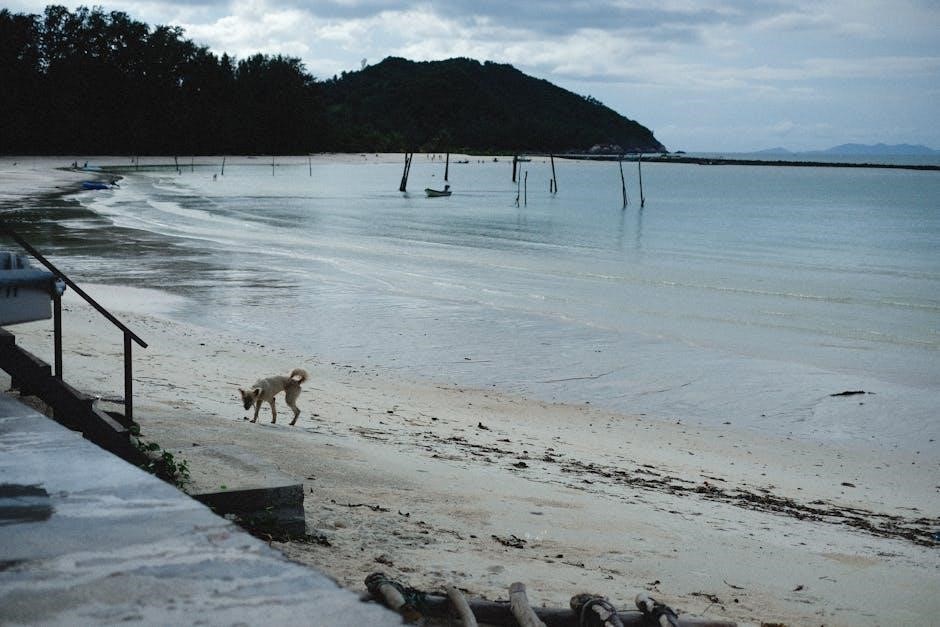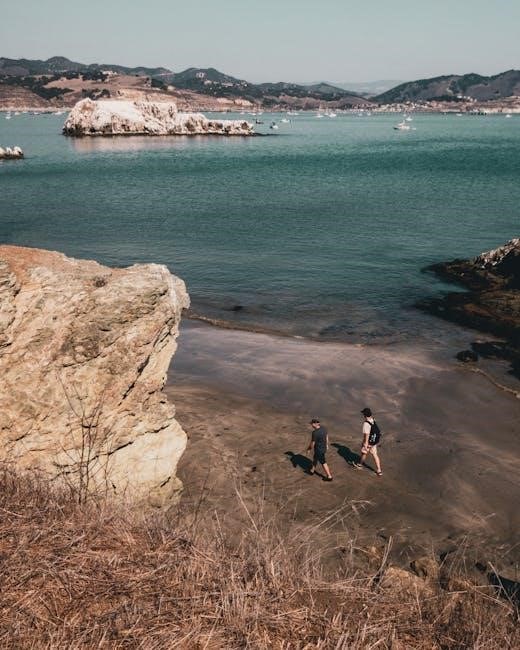Embark on a breathtaking self-guided journey through Tasmania’s Bay of Fires, offering stunning coastal landscapes, white-sand beaches, and orange lichen-covered rocks, perfect for a flexible, personalized adventure.
Overview of the Bay of Fires Region
The Bay of Fires region, located on Tasmania’s northeastern coast, is renowned for its pristine white-sand beaches, crystal-clear turquoise waters, and distinctive orange lichen-covered rocks. Stretching from Binalong Bay to Eddystone Point, this stunning coastline is part of the Mt. William National Park. The area is characterized by its remote and untouched natural beauty, offering a serene environment for hikers to connect with nature. The region’s unique geological features and diverse wildlife make it a standout destination for outdoor enthusiasts. With its dramatic landscapes and tranquil ambiance, the Bay of Fires provides an unforgettable setting for both self-guided and guided walks, allowing visitors to immerse themselves in Tasmania’s unspoiled wilderness.
What Makes the Bay of Fires Walk Unique
The Bay of Fires Walk stands out for its exceptional blend of diverse landscapes and immersive experiences. The trail offers a mix of rugged coastlines, secluded beaches, and serene forests, providing a varied and engaging journey. What truly sets it apart is its ability to cater to both guided and self-guided adventurers, ensuring flexibility and personalization. The walk’s unique features include the opportunity to explore the region’s cultural and historical significance, as well as its abundant wildlife. With its award-winning eco-lodges and sustainable practices, the Bay of Fires Walk promotes environmental stewardship while offering luxurious comfort. Additionally, the walk’s spiritual dimensions, such as encounters with nature and moments of introspection, make it a holistic experience that combines physical activity with mental and emotional rejuvenation, creating a truly unforgettable adventure.
Why Choose a Self-Guided Option
Opting for a self-guided Bay of Fires Walk offers unparalleled flexibility, allowing you to set your own pace and immerse yourself in the natural beauty of Tasmania’s coastline. This option is ideal for those who prefer independence and the freedom to explore without rigid schedules. Self-guided tours enable you to connect deeply with the environment, soaking in the serene landscapes and wildlife at your own leisure. The walk’s well-marked trails and accessible routes make it suitable for hikers of varying fitness levels, ensuring a stress-free experience. Additionally, the availability of eco-lodges and sustainable accommodations along the way provides comfort and convenience, allowing you to focus on the journey rather than logistics. This self-guided approach fosters a sense of adventure and personal accomplishment, making it a rewarding choice for those seeking an authentic and unforgettable experience.

Planning Your Bay of Fires Walk
Plan your self-guided Bay of Fires Walk with a seven-night itinerary, including eco-lodge stays, booking tips, and essential preparation advice for a seamless Tasmanian adventure experience.
Best Time to Undertake the Walk
The ideal time for a self-guided Bay of Fires Walk is between October and May, offering mild temperatures and clear skies. Spring and summer provide optimal conditions, with wildflowers blooming and wildlife active. Autumn is also pleasant, with fewer crowds and comfortable hiking weather. Avoid winter due to colder temperatures and potential rainfall. Plan your itinerary according to your preference for solitude or vibrant natural beauty, ensuring the best experience of Tasmania’s pristine coastline.
How to Book and Prepare
Booking a self-guided Bay of Fires Walk requires advance planning. Research reputable operators like the Tasmanian Walking Company, which offers tailored itineraries and essential support. Secure accommodations early, especially during peak seasons. Prepare by checking the weather forecast and packing appropriate gear, including sturdy hiking boots, layered clothing, and a reliable map. Ensure you have necessary permits and understand the trail markings. Familiarize yourself with the route and potential challenges to ensure a smooth journey. Consider transportation logistics, as some trails may require a 4WD vehicle. Lastly, confirm any specific requirements or restrictions from your tour operator to guarantee a seamless experience.
Essential Gear and Supplies
Packing the right gear is crucial for a self-guided Bay of Fires Walk. Start with sturdy, waterproof hiking boots, moisture-wicking socks, and layered clothing for varying weather conditions. Bring a lightweight backpack, rain jacket, and hat for sun protection. Navigation tools like a detailed map, compass, and GPS device are essential. Carry a first-aid kit, emergency whistle, and headlamp for safety. Include a water bladder or hydration pack, as water sources may be limited. Don’t forget toiletries, biodegradable soap, and hand sanitizer. A portable stove and fuel for meal preparation, along with lightweight, high-energy snacks, will keep you fueled. Lastly, pack a camera to capture the stunning scenery and consider a satellite phone for remote areas. Always check weather forecasts and ensure all gear is in good condition before departure.

Understanding the Route
Discover the diverse landscapes of the Bay of Fires Walk, spanning from rugged coastlines to serene forests, offering a unique blend of natural beauty and tranquility.
Day 1: Stumpys Bay to Boulder Point
Your self-guided adventure begins at Stumpys Bay, where the pristine coastline sets the tone for an unforgettable journey. The first day covers approximately 14 kilometers, taking you through stunning landscapes. You’ll traverse rugged shorelines, white-sand beaches, and dramatic rock formations adorned with vibrant orange lichen. The trail leads you to Boulder Point, a scenic highlight offering breathtaking ocean views. For those seeking a shorter option, an alternative route can reduce the day’s distance, ensuring flexibility for all fitness levels. The day concludes at Deep Creek, nestled within Mt. William National Park, where you’ll find campsites or lodge accommodations to rest and recharge. This diverse introduction to the Bay of Fires Walk blends challenge and beauty, setting the stage for the days ahead.
Day 2: Exploring Mt. William National Park
On the second day of your self-guided Bay of Fires Walk, you delve into the breathtaking landscapes of Mt. William National Park. The trail winds through diverse terrains, offering a mix of coastal views, eucalyptus forests, and heathlands. As you explore, keep an eye out for native wildlife, such as wallabies and birds, that call this park home. The walk is approximately 14 kilometers, with options to adjust the route based on your preference. The park’s rugged beauty and serene atmosphere provide a peaceful backdrop for your journey. By the end of the day, you’ll find yourself at a secluded campsite or lodge, ready to rest and prepare for the next stage of your adventure. This day is a perfect blend of challenge and tranquility, showcasing the natural splendor of Tasmania.
Day 3: Coastal Hike to Ansons River
Day three of your self-guided Bay of Fires Walk takes you along the stunning coastline to Ansons River. This section highlights the dramatic contrast between the turquoise ocean and the fiery orange lichen-covered rocks. The trail is approximately 9 kilometers, offering a mix of beach walking and gentle climbs. As you hike, enjoy the solitude of secluded coves and the rhythmic sound of waves crashing against the shore. Upon reaching Ansons River, you can take a break to relax or even kayak in the calm waters. The evening brings the opportunity to unwind at a nearby campsite or lodge, where you can reflect on the day’s adventures. This leg of the journey is a testament to the region’s untouched beauty and provides a sense of accomplishment as you progress through the walk.
Day 4: She-Oak Forest Walk
Day four of your self-guided Bay of Fires Walk transitions from the coastline to the serene She-Oak Forest. This 6-kilometer section offers a refreshing change of scenery, with the soft rustle of she-oak leaves replacing the ocean breeze. The forest path is well-defined, making it easier to navigate, and the walk typically takes 1.5 to 2 hours to complete. This section provides a unique opportunity to experience the diverse ecosystems of the Bay of Fires region. As you walk, notice the subtle changes in vegetation and the peaceful ambiance of the forest. The shorter duration allows for a more relaxed pace, giving you time to appreciate the natural beauty around you. This day serves as a pleasant contrast to the previous coastal hikes, showcasing the region’s ecological variety and providing a tranquil respite before the final stretch of your journey.
Day 5: Final Stretch to Binalong Bay
The final day of your self-guided Bay of Fires Walk brings you to the picturesque Binalong Bay, a fitting conclusion to your journey. This section offers a mix of coastal views and gentle trails, with the turquoise waters guiding you toward the finish. The walk is approximately 6 kilometers, allowing you to reflect on the diverse landscapes experienced over the past four days. As you approach Binalong Bay, the vibrant colors of the lichen-covered rocks and the pristine beaches create a memorable finale. The terrain is relatively flat, making it an enjoyable end to your adventure. Upon reaching Binalong Bay, take a moment to celebrate your accomplishment and soak in the beauty of this iconic Tasmanian destination. This final stretch encapsulates the essence of the Bay of Fires, leaving you with lasting memories of your self-guided exploration.

Accommodation Options
Experience Tasmania’s Bay of Fires with eco-lodge stays or camping under the stars. Choose between sustainable, solar-powered lodges or scenic campsites along the coastline for a unique adventure.
Camping Along the Bay of Fires
Camping along the Bay of Fires offers a serene and immersive experience, allowing walkers to connect with nature. Scenic campsites are strategically located near beaches and forests, providing stunning views.
These sites are equipped with basic amenities, ensuring a comfortable stay while maintaining the pristine environment. For self-guided walkers, booking campsites in advance is essential, especially during peak seasons;
The freedom of camping lets you enjoy the tranquil evenings, with the sound of waves and the stars above. It’s a perfect way to recharge for the next day’s adventure.
Remember to pack lightweight gear and follow eco-friendly practices to preserve the area’s natural beauty. Camping is a popular choice for those seeking an authentic outdoor experience during their Bay of Fires journey.
Eco-Lodge Accommodation
Eco-lodge accommodation offers a luxurious yet sustainable way to experience the Bay of Fires. These award-winning lodges are designed to blend seamlessly into the environment, using solar power and eco-friendly practices.
Guests enjoy private rooms, shared lounges, and delicious meals prepared by expert guides. The lodges are strategically located near scenic highlights, providing easy access to the trail.
While primarily catering to guided tours, some eco-lodges also welcome self-guided walkers, offering a comfortable retreat after a day of hiking.
Staying at an eco-lodge combines the tranquility of nature with modern comforts, making it an ideal choice for those seeking a balance between adventure and relaxation. It’s a unique way to unwind and recharge for the next day’s exploration of the Bay of Fires.

Self-Guided vs. Guided Tours
Self-guided tours offer flexibility and independence, while guided tours provide expert insights and logistical support, each catering to different preferences for experiencing the Bay of Fires Walk.
Pros and Cons of Self-Guided Tours
Self-guided tours on the Bay of Fires Walk offer unparalleled flexibility, allowing hikers to set their own pace and enjoy solitude. This independence is ideal for those who prefer exploring without a structured itinerary. However, it requires careful planning and self-reliance, as navigation and logistics fall entirely on the participant. While the freedom is rewarding, the lack of expert guidance means missing out on deeper insights into the region’s history and wildlife. Additionally, carrying gear and arranging accommodations can be challenging. Despite these drawbacks, many find the self-guided experience deeply fulfilling, fostering a sense of accomplishment and connection with nature.
Benefits of Joining a Guided Group
Joining a guided group on the Bay of Fires Walk offers a rich, immersive experience with expert insights into the region’s history, wildlife, and hidden gems. Guides provide valuable knowledge and ensure a safe journey, especially in challenging terrain. They handle logistics, including meals and accommodations, allowing participants to focus solely on enjoying the hike. Social interaction with fellow travelers adds a camaraderie that enhances the adventure. Guides also offer tailored support, accommodating varying fitness levels to ensure everyone’s comfort. Additionally, guides often share local stories and cultural significance, enriching the experience beyond mere sightseeing. This structured approach minimizes stress, making the journey more enjoyable and memorable. For many, the expertise and companionship of a guided group elevate the Bay of Fires Walk into a truly unforgettable experience.


Experiencing the Bay of Fires

Discover Tasmania’s Bay of Fires, a pristine landscape of white sands, turquoise waters, and vibrant orange lichen-covered rocks, offering a serene escape into nature’s splendor and tranquility.
Wildlife and Scenic Highlights
The Bay of Fires is a haven for nature enthusiasts, offering a diverse array of wildlife and breathtaking scenery. Along the coastline, you can spot kangaroos, wallabies, and an array of bird species, including eagles and seabirds. The crystal-clear waters provide a habitat for dolphins, seals, and whales during their migration seasons. The landscape is dominated by pristine white-sand beaches, turquoise waters, and iconic orange lichen-covered rocks, creating a visually stunning environment. As you walk through the region, you’ll encounter secluded coves, dense forests, and open heathlands, each teeming with unique flora and fauna. The peaceful surroundings and untouched natural beauty make the Bay of Fires a truly immersive and unforgettable experience, perfect for connecting with nature and capturing unforgettable moments.

Cultural and Historical Significance
The Bay of Fires holds deep cultural and historical importance, particularly for the Indigenous Palawa people, who have lived in harmony with the land for thousands of years. The region is rich in Aboriginal heritage, with evidence of ancient campsites, shell middens, and stone tools scattered across the coastline. The name “Bay of Fires” originates from the numerous fires lit by Aboriginal people along the shore, seen by European explorers in the early 19th century. Today, walkers can immerse themselves in this history by visiting sacred sites and learning about the traditions of the Palawa people. The area also reflects the influence of European settlement, with remnants of early maritime and pastoral activities. This blend of Indigenous and colonial history makes the Bay of Fires a fascinating destination for those seeking to connect with Tasmania’s past.

Staying Safe and Prepared
Always carry safety gear, check weather forecasts, and navigate carefully. Bring emergency supplies and stay hydrated. Seek local guidance to ensure a secure and enjoyable self-guided experience.
Navigating the Terrain
Navigating the Bay of Fires terrain requires careful planning and awareness. The trail spans diverse landscapes, from sandy beaches to rocky coastlines and forested areas. Use detailed maps and GPS devices to stay on track, as some sections can be less marked. Weather conditions, such as rain or strong winds, may affect visibility and path stability. Wear sturdy footwear suitable for uneven ground and potential mud. Carry a compass as a backup and familiarize yourself with the route beforehand. Be mindful of tidal changes, as some coastal sections may be impassable at high tide. Stay hydrated and carry snacks, as water sources are limited. Keep an eye out for signs of erosion or landslides, especially after rainfall. Emergency supplies, such as a first-aid kit and headlamp, are essential for unexpected situations. Always let someone know your itinerary and estimated return time. By staying alert and prepared, you can safely enjoy the stunning scenery of the Bay of Fires.
Weather and Safety Tips
Weather and safety are crucial considerations for a self-guided Bay of Fires Walk. Tasmania’s climate is unpredictable, with sudden rain, strong winds, and cool temperatures, even in summer. Always check forecasts before starting each day. Pack layers of breathable, waterproof clothing and sturdy footwear to handle varying conditions. Stay hydrated by carrying a reusable water bottle and water purification tablets, as natural water sources may be limited. Be cautious of slippery surfaces and loose rocks, especially after rain. Keep emergency supplies, such as a first-aid kit, headlamp, and whistle, easily accessible. Inform someone of your daily route and estimated return time. In case of an emergency, stay calm and seek shelter if possible; Be prepared for changing weather conditions to ensure a safe and enjoyable journey along the Bay of Fires.
Conclude your Bay of Fires Walk with unforgettable memories of Tasmania’s pristine coastline. Stay prepared, embrace flexibility, and immerse yourself in nature’s beauty for a seamless self-guided adventure.
Final Checklist for Success
Ensure a seamless self-guided Bay of Fires Walk by packing essentials: sturdy hiking boots, layers for varying weather, a water filter, and a detailed map. Secure campsite bookings in advance and plan meals to minimize waste. Check the weather forecast and notify someone of your itinerary. Carry a first-aid kit, sunscreen, and insect repellent. Familiarize yourself with the route and landmarks to avoid navigation issues. Bring a portable phone charger for emergencies and enjoy the serene beauty responsibly. Lastly, stay flexible and open to the unpredictable charm of Tasmania’s wilderness, making your adventure both safe and unforgettable.
